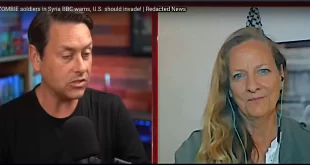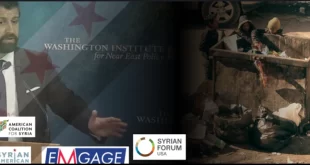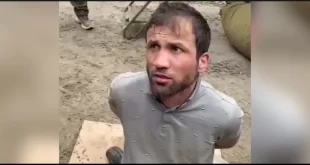by Hamed al-Rubaie, published on The Cradle, August 23, 2023
Add to this the fact that there are numerous recent provocations and clashes between the Syrian army and Idlib based terrorists, and it looks like things are heating up across the country. [Editor]
In a significant development last month, US military convoys rolled into Iraq via the Arar crossing with Saudi Arabia. This visible display of foreign force movements saw a portion of the convoy making its way to the Ain al-Assad base in western Iraq, while the rest headed toward the US occupation base of Al-Tanf in Syria.
In July, the US Department of Defense unveiled its plan to deploy approximately 2,500 soldiers from the 10th Mountain Division, stationed at the Fort Drum military base. Their mission: Operation Inherent Resolve (OIR), the codename for the US-led military campaign against ISIS in Syria and Iraq.
Given the fact that US troops were assumed to be gone from Iraq since last year, pro-US media and political commentators went into overdrive trying to convince a cynical Iraqi public that these new troop movements suggest a healthy development in Washington’s policies toward Baghdad. But will it work?
Syria’s strategic significance
Today, the focal point of the Russian-American-Iranian power struggle in West Asia is in Syria. This strategically located country serves as a pivotal Meditteranean gateway for Russia’s military presence, and is the Arab cornerstone for the Axis of Resistance which extends from Iran to Lebanon and Palestine.
Geopolitically, Syria’s significance derives from its vital location at the crossroads of three continents, and shares borders with five countries: Turkiye (822 km), Iraq (605 km), Jordan (375 km), Lebanon (370 km), and Palestine (76 km). Moreover, Syria’s coastal stretch along the Mediterranean Sea, spanning 192 km, holds tremendous strategic sway in the realm of global security, politics, and economics.
For these multifaceted reasons, Washington has stayed fully engaged on the Syrian file as an important arena from which to curtail Russian and Iranian influence throughout the region. As such, regime change scenarios have played an outsized role in US policy in West Asia.
In 2011, spurred on by the euphoria and optimism of the so-called Arab Spring, anti-government protests erupted in Syria and were very quickly infiltrated by western weapons and agendas.
A plethora of armed factions emerged during this turbulent period, each backed by different foreign states and interests, including the Free Syrian Army, Al-Nusra Front, ISIS, the Syrian Democratic Forces (SDF), and various other armed extremist groups.
By 2012, it became clear that chief among the countries involved in supporting terrorist militias in Syria were the US, Turkiye, Qatar, the UAE, Saudi Arabia, and Israel. In a direct display of support, Washington threw its weight behind the Kurdish-led SDF, offering training and weaponry to help ethnic Kurds carve out an autonomous zone in eastern Syria, emptied of much of its Arab population.
These machinations were not lost on Russia and Iran, who entered the fray upon the request of the Syrian government, and rallied support from the likes of Lebanese Hezbollah and Iraq’s Popular Mobilization Units (PMU).
For much of this conflict, western powers turned a blind eye to the burgeoning activities of terrorists along the Syrian-Iraqi border – and by 2014, ISIS managed to seize control of Mosul and three Iraqi provinces.
The Iraqi-Syrian border, stretching over 605 km, fell under ISIS’s dominion as it severed supply lines to Iraqi factions fighting in Syria. This strategy aimed to force Iran to withdraw its support of Syrian President Assad.
But in an unexpected countermove, mostly Iran-backed Iraqi forces launched campaigns to reclaim territory from ISIS’s grasp. After an arduous 1,200 days of battles, they emerged victorious, wresting control of the Iraqi borders from the grip of the self-proclaimed caliphate.
Disputes on the border
On the Syrian side of the border, the Syrian Arab Army (SAA), aided by Russia and other allies, successfully reclaimed a vast swathe of territory from armed opposition militias, leaving only pockets of militias in eastern Syria, notably in the city of Idlib, where Hay’at Tahrir al-Sham (formerly Al-Nusra Front) dominates.
Of particular concern to the US has been the prominent presence of the Iran-supported PMU along Syria’s borders with Iraq. In order to control that border, the US-led international coalition – occasionally joined by Israeli forces – has launched countless targeted operations against the PMU along the Iraqi border. Washington argues that it does so in “self-defense,” to prevent attacks against US forces stationed at bases like Syria’s al-Tanf and Iraq’s Ain al-Assad.
It is a position unsupported by international law: US forces illegally occupying a sovereign state cannot claim self-defense.
Nevertheless, these dynamics have compelled the US to prioritize the Iraqi border within its broader Syria strategy. As strategic expert Hazem al-Sharaa tells The Cradle:
“These borders are not only part of the Syrian war game but have become part of the Ukrainian war and Washington’s conflict with both Moscow and Tehran.”
Today, control of the al-Qaim (Iraq’s side) border crossing are held firmly by the PMU. When the US feels a need to undermine that control, it makes claims of PMU attacks against US bases and troops, in order to launch a lethal US retaliation at PMU positions.
In the broader picture, Russia – as a steadfast ally and strategic partner to Damascus – also plays a role in tightening the grip around the illegal US occupation of Syria, with Russian forces now reaching a point of contact with the US-backed SDF.
A proxy theater for Russia and the US
This has “raised the American side’s fears of a decline in its influence in Syria,” says Ali al-Shammari, a researcher at Al-Rafidain Center for Strategic Studies. “Washington lost on the Ukraine front, and does not want another loss on the Syrian front,” he tells The Cradle.
For Vladimir Vasiliev, a senior researcher at the Institute for the United States and Canada of the Russian Academy of Sciences, a US loss in Ukraine may ratchet up confrontation in Syria quickly: Washington “is attacking Russia with Ukrainian hands. The failure of this attack will prompt America to resort to a backup plan in Syria.”
On 23 July, 2023, a potentially dangerous episode unfolded as a Russian Air Force fighter jet narrowly avoided a collision with a drone from the US-led coalition. These past months have seen subtle yet palpable tensions grow between US and Russian forces in Syria.
Syrian intelligence sources tell The Cradle that US forces in Syria have increased from 500 to 1,500 soldiers, all of whom have entered the country via the Al-Waleed border crossing from Iraq. Meanwhile, a high-ranking officer within the Iraqi border guards reveals that there are “indications of an upcoming military operation by the US army on the Syrian side of the border with Iraq.”
A senior security source in the Iraqi Counter-Terrorism Service (CTS), on the other hand, reports to The Cradle that “the Americans whom we meet at the Joint Operations Command weekly, and who inform us of all their movements and air strikes inside Iraqi territory against ISIS, did not inform us of any military operation inside Iraqi territory.”
Stakes and alliances
Suspicions over US military ploys grew further on 7 August, when Iraqi Defense Minister Thabet al-Abbasi paid a secret visit to Washington, accompanied by prominent army commanders and the head of the CTS.
Although the details of the visit remain undisclosed, private sources tell The Cradle that Iraqi officials were presented with a new deployment strategy for US forces in eastern Syria. Implementation of this strategy is expected upon the conclusion of US reinforcement efforts.
The sources add that the Americans emphasized the necessity of neutralizing Iraqi Shia armed factions and preventing their involvement in potential clashes between US forces and the SAA along the Iraqi border. As Ghazi Faisal, director of the Iraqi Center for Strategic Studies, tells The Cradle, US interest in Syria appears not to have diminished a whit:
“Washington’s plan in Syria has three axes: forcing Moscow to bring in more forces to Syria to relieve pressure on Ukraine, blocking the Iranian presence in Syria, and cutting off Iran’s supply of advanced missiles to Hezbollah in Lebanon.”
Qamishli, a city situated in northeastern Syria approximately 680 km from Damascus, emerges as a potential epicenter for the brewing confrontation between US and Russian interests, due to the coexisting spheres of influence between US forces and the SDF on one hand, and on the other, the Russian military position at a local airport.
In this intricate mix, several military factions aligned with both Tehran and Damascus also stake a claim on these areas. Kirill Semenov, an expert from the Russian Council for International Affairs, notes that “In the event of any provocation from any party, all possibilities will be available.”
 Syria Support Movement solidarity with the Syrian people
Syria Support Movement solidarity with the Syrian people





